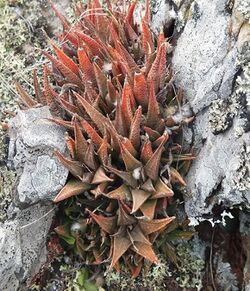Biology:Haworthiopsis venosa
| Haworthiopsis venosa | |
|---|---|

| |
| Scientific classification | |
| Kingdom: | Plantae |
| Clade: | Tracheophytes |
| Clade: | Angiosperms |
| Clade: | Monocots |
| Order: | Asparagales |
| Family: | Asphodelaceae |
| Subfamily: | Asphodeloideae |
| Tribe: | Aloeae |
| Genus: | Haworthiopsis |
| Species: | H. venosa
|
| Binomial name | |
| Haworthiopsis venosa (Lam.) G.D.Rowley[1]
| |
| Synonyms[1] | |
| |
Haworthiopsis venosa, formerly Haworthia venosa, known in Afrikaans as venstertjie, is a species of flowering plant in the genus Haworthiopsis belonging to the family Asphodelaceae, native to Namibia and South Africa.
Naming and taxonomy
The genus name Haworthiopsis means "like Haworthia", which honors the British botanist Adrian Hardy Haworth (1767–1833), while the species epithet venosa means "veined".[2]
The species was previously included in Haworthia subgenus Hexangulares. Phylogenetic studies demonstrated that subgenus Hexangulares was actually relatively unrelated to other haworthias and so it was moved to the new genus Haworthiopsis.[3][4]
Description
It is a mat-forming succulent evergreen perennial reaching 8–60 cm (3–24 in) in height. Stemless rosettes of 12–15 fleshy, triangular, lanceolate, dark green leaves show a few pale green lines along the upper surfaces and small teeth along the margins.
In spring (November to December) it bears 15 cm (6 in) long stems of green-white, tubular flowers in racemes.[5]
Distribution
This species occurs over a large area, from the inland Karoo and Namibia to as far south as the northern part of the Breede River valley.[citation needed] Here it occurs on rocky slopes.
Cultivation
In cultivation it requires a minimum temperature of 10 °C (50 °F), so is grown under glass in temperate locations.[6]
Haworthia venosa subsp. tesselata has won the Royal Horticultural Society's Award of Garden Merit.[7]
References
| Wikimedia Commons has media related to Haworthiopsis venosa. |
- ↑ 1.0 1.1 "Haworthiopsis venosa", World Checklist of Selected Plant Families (Royal Botanic Gardens, Kew), http://wcsp.science.kew.org/namedetail.do?name_id=490894, retrieved 2017-10-17
- ↑ Harrison, Lorraine (2012). RHS Latin for gardeners. United Kingdom: Mitchell Beazley. pp. 224. ISBN 9781845337315.
- ↑ Manning, John; Boatwright, James S.; Daru, Barnabas H.; Maurin, Olivier; van der Bank, Michelle. A Molecular Phylogeny and Generic Classification of Asphodelaceae subfamily Alooideae: A Final Resolution of the Prickly Issue of Polyphyly in the Alooids? Systematic Botany, Volume 39, Number 1, March 2014, pp. 55-74
- ↑ "All about Haworthia". http://www.haworthia.org.uk/haworthia.htm.
- ↑ RHS A-Z encyclopedia of garden plants. United Kingdom: Dorling Kindersley. 2008. pp. 1136. ISBN 978-1405332965.
- ↑ Haworthia venosa - Information page at Haworthia-Gasteria
- ↑ "Haworthia venosa subsp. tesselata". Royal Horticultural Society. https://www.rhs.org.uk/Plants/103603/Haworthia-venosa-subsp-tesselata/Details. Retrieved 21 July 2020.
Wikidata ☰ Q64640887 entry
 |

